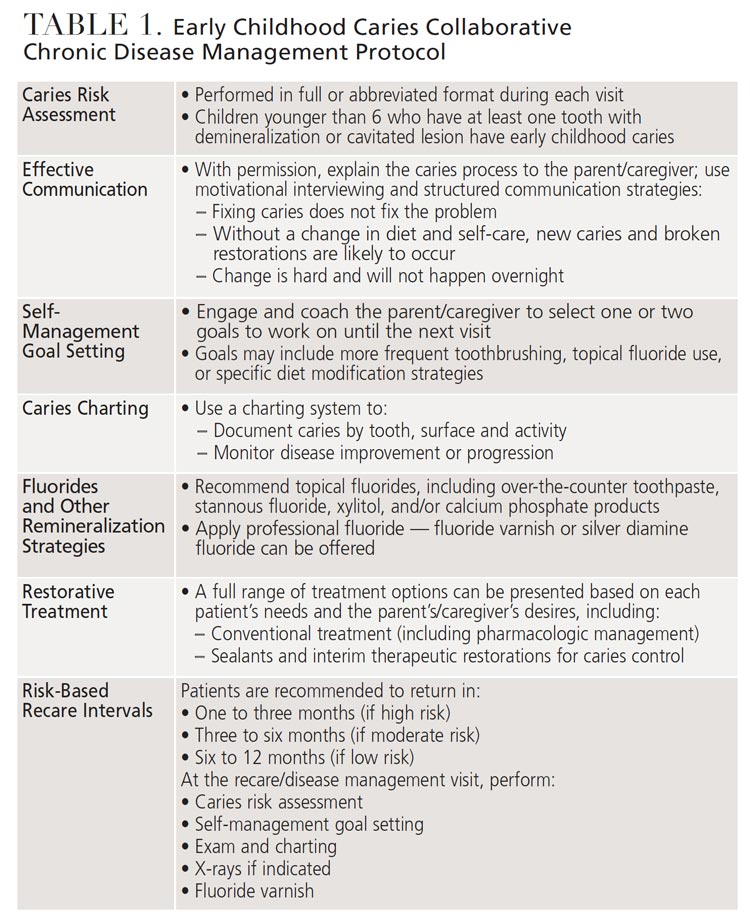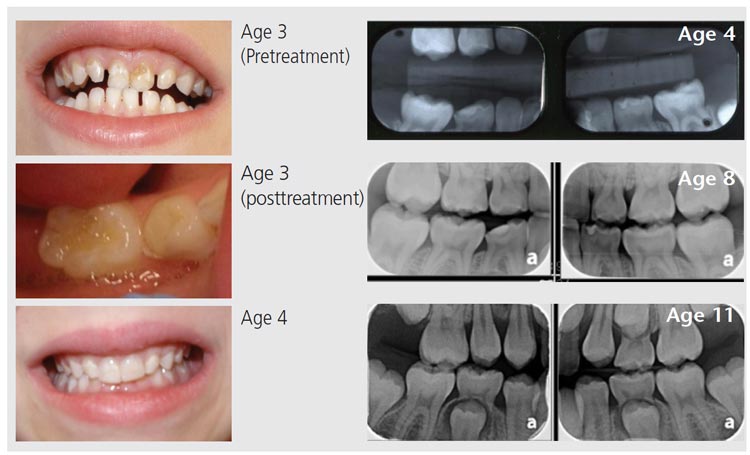 GEBER86/E+/GETTY IMAGES PLUS
GEBER86/E+/GETTY IMAGES PLUS
Role of Goal Setting in Caries Management
Together with risk management and effective communication, establishing goals for the patient will support optimal oral health — especially in children.
Dental caries is a transmissible bacterial infection,1 but also a chronic biobehavioral disease.2 Modern caries management calls for customized, risk-based disease prevention and management strategies.3,4 Restorative treatment of caries alone does not address the underlying disease,3 because without a change in the patient’s etiologic factors, new and recurrent caries will likely occur. Using a chronic disease management (CDM) framework can increase the likelihood that patients will receive personalized preventive and therapeutic care, which can result in improved oral health.5
The dental team is entrusted to educate patients and promote optimal oral health behaviors, while also providing preventive and restorative treatment. By using goal setting and personalized communication strategies, clinicians can engage patients with the goals of altering oral hygiene and dietary habits so individuals can effectively self-manage dental disease.
As a system of coordinated healthcare interventions that emphasizes patient self-care efforts, CDM focuses on self-management strategies using evidence-based protocols.2 Considering caries is a chronic disease significantly influenced by social and behavioral factors, effective disease control requires personalized strategies for each patient. Traditional approaches have often relied on providing general information, with providers telling patients what they should or should not do. General recommendations, such as “brush your teeth twice a day” and “don’t eat candy,” have had limited success.6
Patient-centered approaches, such as CDM, are a more promising means of engaging the patient and parent or caregiver to change specific behaviors. This strategy calls for close collaboration between a patient/parent/caregiver, who is engaged and informed, and a healthcare provider who is proactively promoting behavioral changes.7
The use of CDM requires shared decision-making between clinicians and the patient/parent/caregiver to define problems, set priorities, establish goals, and create treatment plans. Members of the dental team are positioned to identify the etiology of the caries process, educate the patient/parent/caregiver, provide personalized coaching and support to make behavioral changes, and recommend restorative treatment, as needed.
Children with early childhood caries (ECC) often require restorative treatment with sedation or general anesthesia, which presents health risks8 and increases the cost of care.9 Using a CDM framework can help prevent caries, arrest lesions, and slow caries progression.7 In young children, successful CDM may result in the deferral of surgical treatment until they are ready to cooperate with conventional in-office therapy.10
A clinical protocol for managing ECC was implemented in the DentaQuest Institute-sponsored ECC Collaborative (Table 1).5,7 The ECC Collaborative CDM protocol includes seven components: caries risk assessment, effective communication, self-management goal setting, caries charting, fluoride use and other remineralizing strategies, restorative treatment (as needed and desired by the patient/family), and establishing recare interval based on risk. This article will focus on the first three components.
CARIES RISK ASSESSMENT
Risk assessment is the process of establishing the probability of developing new caries over time, which is necessary to understand why lesions occurred, as well as the patient’s risk for future caries.11,12 Structured caries risk assessment forms are available from the American Dental Association,13 American Academy of Pediatric Dentistry14 and other groups; clinicians can also utilize the Caries Management by Risk Assessment protocol.15,16
Understanding and documenting the risk factors (e.g., types and frequency of sugary snacks and beverages); protective factors (e.g., brushing and flossing frequency, and use of fluoride toothpaste); and clinical findings (e.g., lesions by tooth surface and activity, as well as oral hygiene status) helps clinicians support the patient’s behavioral change. Documenting these factors also allows assessment of any changes at subsequent appointments.

EFFECTIVE COMMUNICATION
Obtaining permission from the patient/parent/caregiver is good practice before beginning a conversation concerning caries risk, explaining the caries process, or providing personalized coaching. Under the ECC Collaborative model, visual flip charts and handouts are available to help guide conversations with patients and parents/caregivers. A member of the care team — most often the dental hygienist, but it may be the dentist or dental assistant — coaches the patient/parent/caregiver on self-management goal setting.7 Recognizing that change is difficult to achieve and even harder to sustain, no more than one or two self-management goals are established during a single visit — such as using a high potency fluoride toothpaste or reducing sugar intake.
SELF-MANAGEMENT GOAL SETTING
Motivational interviewing is a potentially fruitful approach to helping patients achieve better oral health outcomes.6,17,18 Miller and Rollnick19 define motivational interviewing as “a client-centered, directive method for enhancing intrinsic motivation to change by exploring and resolving ambivalence.” At its essence, this is a collaborative conversation to strengthen the individual’s motivation to change and empower patients/parents/caregivers to make effective day-to-day behavior modifications that impact oral and systemic health.
Four guiding principles constitute the spirit of motivational interviewing: compassion, acceptance, partnership and evocation (Table 2). In practice, Inglehart,17 who prefers the term motivational communication, advocates moving to a story line approach over several appointments, applying a tailored (rather than a general) strategy, and using therapeutic interventions aimed at changing behaviors.

Additionally, Inglehart17 proposes three steps when planning to motivate a specific oral health behavioral change.
Step 1 is determining which behavioral change to target.
Step 2 is understanding the affective-behavioral and cognitive status quo of the patient/parent/caregiver in order to customize communication to the patient’s situation. For example, how does the patient feel about the behavioral change? What are the patient’s skills to engage in the behavior, and/or which previous behaviors did the patient engage in? What does the patient know and believe about the behavioral change?
Step 3 is knowing which stage of change the patient is in — because if the patient is not interested in a behavioral change, it is not reasonable to expect change.17
Four tools, represented by the acronym OARS, are used in motivational interviewing to elicit behavioral changes: open-ended questions, affirmations, reflective listening, and summaries. Asking open-ended questions allows patients to say what change they would like to make, thus encouraging “change talk.” It is not the advice of the healthcare provider but, rather, the desire of the patient that determines which changes can be accomplished.20 Being affirmative acknowledges change and helps build trust. Reflective listening in response to a patient’s statement allows the patient to feel heard. Summarizing ensures that the patient and care provider are on the same page.17
In the ECC Collaborative, structured communication is also used to convey empathy while sharing important concepts with patients and families. Examples include:
- Restoring caries does not fix the larger problem
- Without a change in diet and self-care, new caries are likely to occur
- Change is hard and will not happen overnight

PRACTICE EXAMPLE
Figure 1 demonstrates images and radiographs of a patient successfully treated with the ECC Collaborative CDM protocol. The patient initially presented at age 3 with ECC and was referred for restorative treatment under general anesthesia. Her parents preferred trying the CDM protocol and chose two self-management goals: to switch from drinking diluted juice to drinking mostly water, and brushing with fluoride toothpaste instead of nonfluoride (training) toothpaste. They also agreed to return for recare visits and professional fluoride varnish applications every three months. Over time, the patient’s caries lesions were successfully arrested. After several “easy” recare visits, the patient allowed completion of interim restorative treatment on teeth L and S, placement of sealants, and completion of composite restorations on the maxillary incisors. Teeth L and S eventually exfoliated without requiring additional treatment.
DENTAL TEAM’S ROLE
The implementation of CDM requires dental professionals to work collaboratively with the patient/parent/caregiver to address specific risk factors. Various members of the dental team play pivotal roles in the CDM approach. Every patient encounter is an opportunity to review caries risk factors and self-management goals, and provide focused, risk-based education, coaching and support. Even during restorative treatment, dental support staff — including dental assistants, dental hygienists or administrative team members — may reassess risk factors and provide ongoing self-management support.
By using goal setting and personalized communication strategies, each member of the team can engage patients to improve their oral health by altering caries risk behaviors and practicing more effective self-care.
KEY TAKEAWAYS
- Dental caries is a transmissible bacterial infection,1 but also a chronic biobehavioral disease.2
- Using a chronic disease management (CDM) framework can increase the likelihood that patients will receive personalized preventive and therapeutic care, which are crucial steps in effective caries management.
- By using goal setting and personalized communication strategies, clinicians can engage patients with the goals of altering oral hygiene and dietary habits so individuals can effectively self-manage dental disease.
- The use of CDM requires shared decision-making between clinicians and the patient/parent/caregiver to define problems, set priorities, establish goals, and create treatment plans.
- Motivational interviewing is a potentially fruitful approach to helping patients achieve better oral health outcomes.6,17,18
- At its essence, this is a collaborative conversation to strengthen the individual’s motivation to make effective day-to-day behavior modifications that positively impact oral and systemic health.
- By using goal setting and personalized communication strategies, each member of the dental team can engage patients to improve their oral health by altering caries risk behaviors and practicing effective self-care.
REFERENCES
- Featherstone JD. The science and practice of caries prevention. J Am Dent Assoc. 2000;131:887–899.
- Edelstein BL, Ng MW. Chronic disease management strategies of early childhood caries: support from the medical and dental literature. Pediatr Dent. 2015;37:281–287.
- Fontana M, Wolff M. Translating the caries management paradigm into practice: challenges and opportunities. J Calif Dent Assoc. 2011;39:702–708.
- Young DA, Lyon L, Azevedo S. The role of dental hygiene in caries management: a new paradigm. J Dent Hyg. 2010;84:121–129.
- Ng MW, Fida Z. Dental hygienist-led chronic disease management system to control early childhood caries. J Evid Based Dent Pract. 2016;16:20–33.
- Albino J, Tiwari T. Behavior change for caries prevention: understanding inconsistent results. JDR Clin Trans Res. 2020;5:6–9.
- Ng MW, Ramos-Gomez F, Lieberman M, et al. Disease management of early childhood caries: ECC Collaborative Project. Int J Dent. 2014;2014:327801.
- Sinner B, Becke K, Engelhard K. General anaesthetics and the developing brain: an overview. Anaesthesia. 2014;69:1009–1022.
- Berkowitz RJ, Amante A, Kopycka-Kedzierawski DT, Billings RJ, Feng C. Dental caries recurrence following clinical treatment for severe early childhood caries. Pediatr Dent. 2011;33:510–514.
- Meyer BD, Lee JY, Thikkurissy S, Casamassimo PS, Vann WF Jr. An algorithm-based approach for behavior and disease management in children. Pediatr Dent. 2018;40:89–92.
- Fontana M. The clinical, environmental, and behavioral factors that foster early childhood caries: evidence for caries risk assessment. Pediatr Dent. 2015;37:217–225.
- Pitts EI, Fontana M. The role of the dental hygienist in caries risk assessment. Dimensions of Dental Hygiene. 2018;16(7):21–24.
- American Dental Association. Caries Risk Assessment Form (Age 0–6). Available at: http/://www.ada.org/~/media/ADA/Member%20Center/FIles/topi_s_caries_under6.ashx. Accessed July 9, 2021.
- American Academy of Pediatric Dentistry. Guideline on caries-risk assessment and management for infants, children and adolescents. Pediatr Dent. 2016;38:142–149.
- California Dental Association Foundation. Caries Management by Risk Assessment. Available at: https://www.cda.org/portals/0/journal/journal_102007.pdf. Accessed July 9, 2021.
- Ramos-Gomez FJ, Crall J, Gansky SA, Slayton RL, Featherstone JD. Caries risk assessment appropriate for the age 1 visit (infants and toddlers). J Calif Dent Assoc. 2007;35:687–702.
- Inglehart MR. Motivational communication in dental practices: prevention and management of caries over the life course. Dent Clin North Am. 2019;63:607–620.
- American Academy of Pediatric Dentistry. Perinatal and infant oral health care. Pediatr Dent. 2017;39:208–212.
- Miller WR, Rollnick S. Motivational Interviewing: Preparing People for Change. 2nd ed. New York: Guilford Press; 2002.
- Croffoot C, Krust Bray K, Black MA, Koerber A. Evaluating the effects of coaching to improve motivational interviewing skills of dental hygiene students. J Dent Hyg. 2010;84:57–64.
The authors have no commercial conflicts of interest to disclose.
From Decisions in Dentistry. August 2021;7(8)10-13.


